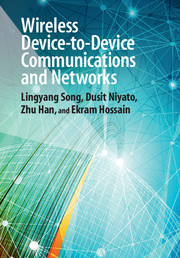Book contents
- Frontmatter
- Dedication
- Contents
- Preface
- Part I Introduction
- 1 Basics of D2D communications
- Part II Techniques for modeling and analysis of D2D communications
- Part III Resource management, cross-layer design, and security for D2D communications
- Part IV Applications of D2D communications
- Part V Standardization of D2D communications
- References
- Index
1 - Basics of D2D communications
from Part I - Introduction
Published online by Cambridge University Press: 05 March 2015
- Frontmatter
- Dedication
- Contents
- Preface
- Part I Introduction
- 1 Basics of D2D communications
- Part II Techniques for modeling and analysis of D2D communications
- Part III Resource management, cross-layer design, and security for D2D communications
- Part IV Applications of D2D communications
- Part V Standardization of D2D communications
- References
- Index
Summary
As one of the next-generation wireless communication systems, the Third Generation Partnership Project (3GPP) Long Term Evolution (LTE) is committed to providing technologies for high data rates and system capacity. Further, LTE-Advanced (LTE-A) was defined to support new components for LTE to meet higher communication demands [1]. In particular, the performance and quality of service (QoS) of local area services need to be improved significantly by reusing the spectrum resources. However, reuse of the unlicensed spectrum might not provide a stable controlled environment [2]. Therefore, the approach of exploiting the licensed spectrum for local area services has attracted much attention. In this chapter, we present the basic concepts of device-to-device (D2D) communications in the licensed spectrum bands. We first provide an overview of D2D communications underlaying the cellular network. We then discuss access methods, device synchronization, and discovery mechanisms. Next, mode selection, spectrum sharing, power control, and multiple-input-multiple-output (MIMO) techniques are briefly introduced. The concepts of D2D direct and D2D local area networks (LANs) are proposed, a simulation scenario for D2D direct is given as an example, and, finally, the issues and challenges in D2D communications are outlined.
Overview of D2D communications
The term D2D communications commonly refers to the techniques that enable devices to communicate directly without an infrastructure of access points or base stations. D2D communications amount to a technology component for LTE-A, where user equipments (UEs) transmit data signals to each other over a direct link/connection using the cellular resources instead of through the eNB (i.e., a base station). As an underlay to the cellular network, D2D communications allow one to increase the spectral efficiency [1, 3, 4, 5, 6, 7, 8, 9]. While D2D communications is considered as an add-on component in the 4G systems, it is expected to be a native feature supported by the next-generation (e.g., fifth-generation [5G]) cellular networks.
- Type
- Chapter
- Information
- Publisher: Cambridge University PressPrint publication year: 2015
- 1
- Cited by



